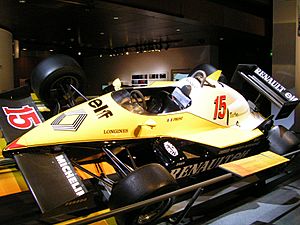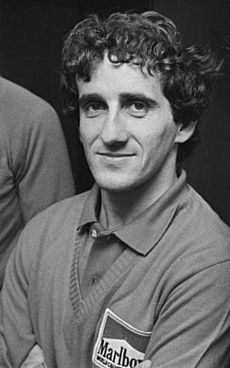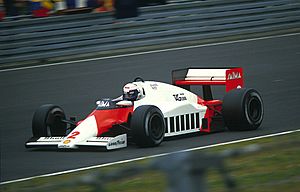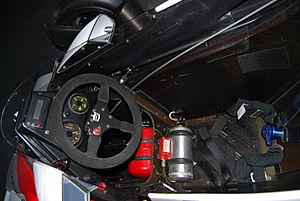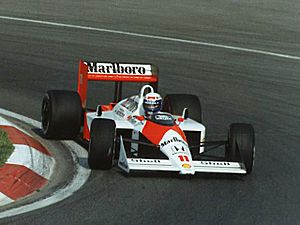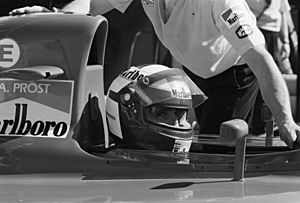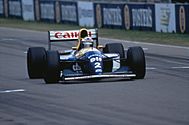Alain Prost facts for kids
Quick facts for kids
Alain Prost
|
|
|---|---|
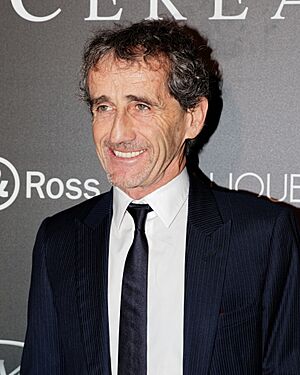
Prost in 2015
|
|
| Born |
Alain Marie Pascal Prost
24 February 1955 Lorette, Loire, France
|
| Spouse(s) |
Anne-Marie Barges
(m. 1980; div. 2017) |
| Children | 3, including Nico |
| Formula One World Championship career | |
| Nationality | |
| Active years | 1980–1991, 1993 |
| Teams | McLaren, Renault, Ferrari, Williams |
| Entries | 202 (199 starts) |
| Championships | 4 (1985, 1986, 1989, 1993) |
| Wins | 51 |
| Podiums | 106 |
| Career points | 768.5 (798.5) |
| Pole positions | 33 |
| Fastest laps | 41 |
| First entry | 1980 Argentine Grand Prix |
| First win | 1981 French Grand Prix |
| Last win | 1993 German Grand Prix |
| Last entry | 1993 Australian Grand Prix |
| Signature | |
 |
|
Alain Marie Pascal Prost (born 24 February 1955) is a French former racing driver. He competed in Formula One from 1980 to 1993. People called him "the Professor" because he was very smart and careful in his racing.
When he retired, Prost had won four Formula One World Drivers' Championship titles. He also held records for most wins (51), fastest laps (41), and podium finishes (106).
Born in Lorette, Loire, France, Prost started karting at age 14. He won the junior Karting World Cup four years later. He then moved up to bigger racing cars in 1976. Prost won his first title in the Formula Renault National Championship that year. He continued to win championships in 1977, 1978, and 1979.
Prost joined McLaren in 1980, making his Formula One debut in Argentina. He finished sixth in that race. He moved to Renault in 1981. There, he won his first Formula One race at his home Grand Prix in France. He also won races in the Netherlands and Italy.
In 1983, Prost finished second in the World Drivers' Championship. He lost the title after his car had a problem in the last race. Renault fired Prost shortly after, and he returned to McLaren for 1984. He finished second again, losing to his teammate Niki Lauda by a very small half-point.
In 1985, Prost won his first championship with McLaren. He became the first French Formula One World Champion. He won again in 1986 after a close fight with Nelson Piquet and Nigel Mansell. In 1988, Ayrton Senna joined McLaren as his teammate. They won almost all races that year, but Senna took the championship.
Prost and Senna had a very strong rivalry. They crashed into each other in the final races of 1989 and 1990. Prost won the 1989 championship, and Senna won in 1990. Prost moved to Ferrari in 1990. After a tough 1991 season, Ferrari fired him.
Prost took a break in 1992. He returned with Williams in 1993. He won his fourth championship that year and retired from racing. He later owned his own Formula One team, Prost Grand Prix, from 1997 to 2001. From 2017 to 2021, he worked as an advisor for the Renault team, which later became Alpine.
After retiring from Formula One, Prost also raced in other events. He won a race in the 2005 FFSA GT Championship. He also competed in ice racing, winning the Andros Trophy three times. He was also a co-owner of a team in Formula E, called Renault e.dams, which won three team championships. Prost was added to the International Motorsports Hall of Fame in 1999.
Contents
Early Life and Karting Success
Alain Prost was born in Lorette, Loire, France. His father owned a furniture store. Alain had an older brother, Daniel, who passed away in 1986.
Prost was a very active child. He enjoyed many sports like wrestling and football. He even broke his nose several times! He thought about becoming a gym teacher or a professional footballer. But then, at age 14, he found kart racing during a family holiday. This new sport quickly became his main goal. When he was 16, he bought his first kart with money he saved from working in his father's shop.
Prost won many karting championships as a teenager. In 1974, he became a full-time racer. He won the French senior karting championship in 1975.
Moving Up in Racing
In 1976, Prost started racing in open-wheel cars. He quickly moved through the junior racing levels. That year, he won the French Formula Renault title, winning almost every race. In 1977, he won the Formula Renault European championship.
In 1978, he won the French Formula Three championship. He also raced in the European Formula Three series. In 1979, he won both the European and French Formula Three titles. His success in Formula Three caught the attention of Formula One teams.
Formula One Career
Starting with McLaren (1980)
After winning the European Formula Three title, Prost was wanted by Formula One teams like McLaren, Brabham, and Ligier. He impressed McLaren's team boss, Teddy Mayer, during a test drive. McLaren signed him for the 1980 season. His teammate was John Watson.
Prost's Formula One career started well. In his first race in Argentina, he finished sixth and scored a point. This was a rare achievement for a new driver. He scored points in four races that year. However, he also had several accidents. He broke his wrist during practice in South Africa and had a concussion in the United States.
At the end of the season, Prost left McLaren. He felt the car often broke down and that the team blamed him for accidents. He signed with Renault.
Racing for Renault (1981–1983)
Prost joined fellow Frenchman René Arnoux at Renault for 1981. There were problems between them from the start. Prost was faster than his more experienced teammate. He didn't finish his first two races due to crashes. But then, he got his first podium finish in Argentina.
Prost won his first Formula One race at his home Grand Prix in France. He finished two seconds ahead of his old teammate, John Watson. This win changed his mindset. He said, "Before, you thought you could do it. Now you know you can." Prost won two more races that season in the Netherlands and Italy. He finished fifth in the Drivers' Championship.
In 1982, Prost won the first two races in South Africa and Brazil. He finished in the points four other times. But he didn't win any more races that year. He retired from seven races. His relationship with Arnoux got worse after the French Grand Prix. Prost believed Arnoux, who won the race, broke a promise to help him.
In November 1982, Prost raced in a non-championship event in Australia. He won the 1982 Australian Grand Prix.
In 1983, Eddie Cheever became Prost's new teammate. Prost won four more races for Renault that season. He finished second in the Drivers' Championship, just two points behind Nelson Piquet. Prost felt the team was too careful in developing the car. He argued with Renault's management, who blamed him for not winning the championship. Renault fired Prost two days after the last race. He quickly signed with McLaren for the 1984 season. He also moved his family to Switzerland after some Renault factory workers burned two of his cars in France.
Returning to McLaren (1984–1989)
Close Battles and First Titles (1984–1986)
Prost joined two-time world champion Niki Lauda at McLaren in 1984. He drove the McLaren MP4/2 car, which used a TAG-Porsche engine. He lost the world championship to Lauda in the last race by only half a point. This was despite winning seven races, more than Lauda's five. The half point came from the 1984 Monaco Grand Prix. That race was stopped early due to heavy rain, and only half points were given. Prost's seven wins in 1984 matched a record set by Jim Clark. Lauda's half-point win is the closest title race in Formula One history.
In 1985, Prost became the first French Formula One World Champion. He won five races that season. He also won the 1985 San Marino Grand Prix, but he was disqualified because his car was too light. Prost finished 20 points ahead of his closest rival, Michele Alboreto. For his win, Prost received the Légion d'honneur award in France. At the end of the season, Lauda retired. He said Prost's speed made him decide to retire.
Keke Rosberg replaced Lauda at McLaren for 1986. Prost successfully defended his title. His car struggled against the powerful Williams cars driven by Nelson Piquet and Nigel Mansell. In the final race of the season in Australia, Mansell had a tire failure and crashed. This allowed Prost to win the race and the championship. Prost became the first driver to win two titles in a row since Jack Brabham in 1960.
Another memorable race for Prost that year was in San Marino. He was leading easily when his car started to run out of fuel near the end. He managed to keep it going just long enough to cross the finish line and win. At the 1986 German Grand Prix, his car ran out of fuel on the last lap. Prost got out and tried to push his car to the finish line, but it was too far. He was still counted as sixth place because other cars were further behind.
New Teammate and Rivalry (1987–1989)
Stefan Johansson joined McLaren as Prost's teammate for 1987. McLaren had a new car, but the TAG engines were not as strong as before. Prost still challenged Piquet and Mansell for the title. He won three races and broke Jackie Stewart's record for most race victories. Stewart said he was happy Prost broke his record because he deserved it. Prost considers his win in the first race in Brazil as his best ever. He started fifth but had a great race setup that saved his tires. He finished 40 seconds ahead of Piquet.
Prost finished the 1987 season in fourth place. This was his lowest championship finish since his first year in 1980.
The 1988 season was a big moment for Formula One. Honda, a powerful engine supplier, joined McLaren. Honda wanted to sign either Nelson Piquet or Ayrton Senna. Prost suggested Senna, praising his youth and talent. This was a decision he would later regret.
McLaren promised Prost and Senna would be treated equally. But Prost became suspicious. The McLaren-Honda team was incredibly dominant, winning 15 out of 16 races. Prost finished first or second in almost every race. He won seven races and scored more points than Senna. However, Senna won the championship by three points. This was because only the best 11 results counted towards the championship.
Prost started to believe Honda favored Senna. He even found an engine crate marked "Special - For Ayrton." McLaren's boss, Ron Dennis, supported Prost. He said the team found differences in the engines given to Senna and Prost. To be fair, Dennis tried to give engines randomly, like with a coin flip.
Things got worse at the 1989 Italian Grand Prix. Prost announced he would join Ferrari in 1990. After this, McLaren seemed to support Senna more. Prost won the race, and Senna retired. Prost then threw his winner's trophy into the crowd of Ferrari fans, which made Ron Dennis very angry. McLaren then made a rule that all trophies belonged to the team.
Prost won his third championship at the 1989 Japanese Grand Prix. He was 16 points ahead of Senna. Senna needed to win the last two races. Prost and Senna crashed with seven laps to go. Prost was leading and didn't leave a gap for Senna. Senna restarted his car and won the race. But the FIA (the racing authority) disqualified him for missing a turn. They also fined him and banned him for six months. Prost later said he didn't crash on purpose, but he also didn't "open the door" for Senna.
Moving to Ferrari (1990–1991)
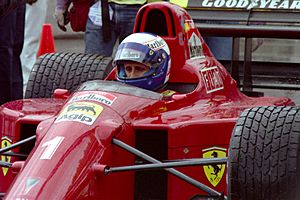
In 1990, Prost joined Ferrari. He was the first Ferrari driver to sign after the team's founder, Enzo Ferrari, passed away. The 1990 Ferrari 641 car was very strong. Ferrari almost won the Constructors' Championship, finishing just 11 points behind McLaren. Prost won five races for Ferrari that year. In Mexico, he started 13th and won, which was one of his best drives.
The championship again came down to the second-to-last race in Japan. This time, Prost was behind Senna. In the first corner of the first lap, Senna intentionally crashed into Prost. This took both of them out of the race and gave Senna the title. Prost was very angry, saying Senna's actions were "disgusting." Senna later admitted he crashed on purpose to get back at Prost for the 1989 incident. Prost finished the season seven points behind Senna.
At the end of 1990, Mansell left Ferrari. He said his relationship with Prost was difficult. Mansell claimed Prost used his status as the team's lead driver. Prost said Mansell rarely attended team meetings. Jean Alesi replaced Mansell.
The 1991 season was tough for Ferrari. Their car, the Ferrari 642, was not as good as the McLaren and Williams cars. Prost didn't win any races and only had five podium finishes. Ferrari's V12 engine was not as competitive as the smaller, lighter V10 engines of other teams.
Prost became frustrated and publicly called the car a "truck." Ferrari fired him with one race left in the season. Gianni Morbidelli replaced him for the last race.
Final Championship with Williams (1993)
Prost took a break from racing in 1992. Ferrari paid him a lot of money to take the year off. During this year, Nigel Mansell dominated with the Williams-Renault car and won the title easily. Honda decided to leave Formula One at the end of the season. Everyone expected a Williams driver to win the title again in 1993.
Prost quickly saw how good the Williams car was. He started talking to Frank Williams about racing for them in 1993. He signed a two-year contract. Prost had a special clause in his contract that stopped Senna from joining the team in 1993. Senna was very angry and called Prost a "coward."
Prost won his fourth and final title in 1993. His teammate was Damon Hill. Williams-Renault had another dominant car that year. Prost won seven of the first ten races and took pole position in 13 out of 16 races. He finished 26 points ahead of Senna and won the title with two races left. The British government gave Prost an OBE award for his success.
Before winning the title, Prost announced he would retire at the end of the season. He later said that Renault, Williams' engine supplier, pressured Frank Williams to let Senna join the team in 1994. As a compromise, Prost agreed to retire after 1993, and Williams paid him his salary for 1994. This allowed Senna to join Williams.
Prost finished on the podium in his last race in Australia in 1993. After the race, Senna surprisingly hugged him. Prost was very touched by this. McLaren offered Prost a chance to unretire for 1994, but he was not impressed by their new car. He retired for good.
Helmet Design

Prost's helmet design used the three colors of the French flag: blue, white, and red. His name was written on the side. Early in his career, his helmet was mostly white with some blue around the visor. When he was at Renault, he added more blue details. In 1985, his helmet design changed to have blue around the front and a white circle with red lines on top. He kept a similar design for Ferrari and Williams.
Career Legacy
Many people consider Prost one of the greatest Formula One drivers ever. He has the fourth-most Drivers' Championships of all time. When he retired, Prost held the record for most Grand Prix wins (51). Michael Schumacher broke this record in 2001. Prost also held the record for most fastest laps (41) until Schumacher broke that in 2001.
Prost shares the record for starting from the front row in every race of a single season (16 out of 16 in 1993). As of 2025, he is the last Frenchman to have won his home Grand Prix.
Driving Style
Prost was called "The Professor" because he was very smart and thoughtful in his racing. He was good at setting up his car for race conditions. He would often save his brakes and tires early in a race. This made them fresher for a strong finish. His motto was to "win as slowly as possible." This meant he wanted to win by doing just enough, without pushing the car too hard.
Prost had a smooth and relaxed driving style. He learned from drivers like Jackie Stewart and Jim Clark. Stewart praised Prost for his smooth driving, calling it "artistry." Prost's calm style helped him get the most out of his engine without breaking it.
While Senna was faster in qualifying, Prost was excellent on race day. In the races they competed in together, Prost had 12 fastest laps compared to Senna's 6.
Team Changes
Prost understood that racing with the best cars was important. He was good at joining the right teams at the right time. However, he sometimes had difficult relationships with his teams and engine suppliers. Formula One's website notes that he "left teams unhappily on four occasions."
For example, his teammate at Ferrari, Nigel Mansell, said that at the 1990 British Grand Prix, his car felt different. He found out that Prost had secretly asked for Mansell's car because he thought it was better. Prost also spoke fluent Italian, which gave him more influence at Ferrari. Prost was fired from Ferrari in 1991 for criticizing the car. He took 1992 off rather than race for a less competitive team.
Prost quickly saw the potential of the Williams-Renault team in 1992. He signed with them for 1993 and 1994. He retired at the end of 1993 because he didn't want to be teammates with Senna in 1994. After Senna passed away in 1994, Prost said he would not race in Formula One again out of respect for Senna.
What Others Said About Him
In a 2009 survey of 217 Formula One drivers, Prost was voted the fourth greatest Formula One driver of all time. He was behind Senna, Schumacher, and Fangio. His teammate Keke Rosberg said Prost was "the best I've ever known." Formula One CEO Bernie Ecclestone once said Prost was the greatest driver because he rarely had special treatment as a number one driver.
Rivalry with Ayrton Senna
Prost's battles with Ayrton Senna were famous. They were very strong competitors and had several well-known incidents on track:
- Estoril 1988: Senna tried to block Prost by almost pushing him into the pit wall.
- Imola 1989: They disagreed about a pre-race agreement not to race too closely on the first lap.
- Suzuka 1989: Prost turned into Senna's path, causing a crash, which helped Prost win the championship.
- Suzuka 1990: Senna intentionally crashed into Prost to win the championship, as revenge for the 1989 incident.
- Hockenheim 1991: Senna forced Prost off the track.
After the 1991 Hockenheim incident, the racing authorities made them meet to calm things down.
After the 1992 season, both drivers wanted to join Williams-Renault, which was the best team. Prost famously blocked Senna from joining the team in 1993. Senna publicly called Prost a "coward." Senna's fans in Brazil were so angry that Prost needed a police escort at the 1993 Brazilian Grand Prix. Prost won the 1993 title and retired, allowing Senna to join Williams in 1994.
Once they were no longer competing, their relationship began to improve. At Prost's last race in Australia in 1993, Senna pulled him onto the top step of the podium for a hug. Just days before Senna's tragic passing in 1994, he sent a special greeting to Prost on French television, saying, "We all miss you Alain." Prost was very touched by this. Prost was a pallbearer at Senna's funeral. He said that when Senna passed away, "a part of himself had died also," because their careers were so connected.
Later Life and Activities
In 1994 and 1995, Prost worked as a TV commentator for a French channel. He also worked for Renault in public relations. He returned to his old team, McLaren, as a technical adviser.
Prost Grand Prix
In 1989, Prost thought about starting his own racing team. He almost started a team with John Barnard in 1990, but they couldn't find enough sponsors.
On February 13, 1997, Prost bought the Ligier team and renamed it "Prost Grand Prix." He signed a three-year deal with French car maker Peugeot for engines. For the first season, Prost kept one of Ligier's drivers, Olivier Panis, who had won the 1996 Monaco Grand Prix. The team started well, scoring points in its first race. But Panis broke his leg in an accident, and the team struggled after that. Prost GP finished sixth in the Constructors' Championship in its first year.
Prost became the president of Prost Grand Prix in 1998. The team only scored one point that year. In 1999, Prost hired John Barnard as a technical consultant. The car was okay, but the Peugeot V10 engine was heavy and not reliable.
In 2000, Jean Alesi joined Prost GP as a driver. The car was unreliable and hard to handle. The drivers even crashed into each other in one race. Prost made changes to the team's management.
In 2001, Ferrari agreed to supply engines for the team. But the money ran out at the start of the 2002 season. Prost Grand Prix went out of business, owing about $30 million.
Other Roles and Activities
In 2002, Prost spent time with his family. He also competed in bicycle races and the Andros ice race series. He won the Andros Trophy three times with Toyota and Dacia.
In 2010, Prost was the first former driver to serve on the stewards' panel in Formula One races. He also took part in the Race of Champions, where racing legends compete. In 2012, Renault named Prost their new international ambassador. He also completed a tough mountain bike race in South Africa twice.
In 2013, Prost teamed up with Jean-Paul Driot to form e.dams. This team competed in the FIA Formula E Championship for electric racing cars. The team won the first Formula E teams championship. Prost also worked as a TV commentator for Channel 4 F1 in 2016.
In 2017, he became a special adviser for the Renault Formula One Team. In 2019, he became a non-executive director for Renault Sport. At the 1000th Formula One race, Prost waved the checkered flag. He left the team in January 2022.
Personal Life
Prost was married to Anne-Marie, and they have two sons, Nicolas (born 1981) and Sacha (born 1990). Prost also has a daughter, Victoria, born in 1996. Nicolas raced in Formula E for a team partly run by his father.
The Prost family moved to Switzerland in 1983 after some people burned his cars in France. They lived there until 1999, when they moved to Nyon, Switzerland. Prost has two grandsons through Nicolas and another grandson through Sacha.
In 1986, the French President gave Prost the Légion d'honneur award. He was promoted to a higher rank in 1993. He also received an honorary British OBE in 1994 and a Brazilian award in 1999. He was inducted into the International Motorsports Hall of Fame in 1999.
Besides French, Prost also speaks fluent English and Italian.
Karting Record
Karting Career Summary
| Season | Series | Team | Position |
|---|---|---|---|
| 1973 | French Championship — Junior | 1st | |
| French Championship — Senior | 2nd | ||
| European Championship — Junior | 1st | ||
| FIA Karting World Championship — Junior | 1st | ||
| FIA Karting World Championship — Senior | 14th | ||
| 1974 | French Championship — Senior | 1st | |
| FIA Karting World Championship — Senior | 23rd | ||
| 1975 | French Championship — Senior | 1st (DSQ) | |
| FIA Karting World Championship — Senior | 9th | ||
| Sources: | |||
Racing Record
Career Summary
| Season | Series | Team | Races | Wins | Poles | F/Laps | Podiums | Points | Position |
|---|---|---|---|---|---|---|---|---|---|
| 1976 | Formule Renault Nationale | Ecurie Elf | 13 | 12 | 10 | 11 | 12 | 112 | 1st |
| Challenge de Formule Renault Europe | Equipe Danielson | 2 | 0 | 1 | 0 | 0 | 1 | 28th | |
| 1977 | Challenge de Formule Renault Europe | 16 | 6 | 4 | 7 | 10 | 157 | 1st | |
| European Formula Two | Willi Kauhsen Racing Team | 2 | 0 | 0 | 0 | 0 | 0 | NC | |
| 1978 | French Formula Three | Ecurie Elf | ? | ? | ? | ? | ? | ? | 1st |
| European Formula Three | 8 | 1 | 1 | 1 | 1 | 10 | 9th | ||
| Super Visco British Formula Three | 2 | 0 | 0 | 0 | 1 | 7 | 13th | ||
| Vandervell British Formula Three | 1 | 0 | 0 | 0 | 1 | 18 | 9th | ||
| European Formula Two | Fred Opert Racing | 1 | 0 | 0 | 0 | 0 | 0 | NC | |
| 1979 | French Formula Three | Ecurie Elf | 5 | 5 | 4 | 5 | 5 | 75 | 1st |
| FIA European Formula 3 Championship | 10 | 6 | 5 | 6 | 8 | 67 | 1st | ||
| British Formula Three | 1 | 0 | 0 | 0 | 0 | 4 | 12th | ||
| 1980 | Formula One | Marlboro Team McLaren | 13 | 0 | 0 | 0 | 0 | 5 | 16th |
| BMW M1 Procar Championship | BMW Motorsport | 1 | 0 | 0 | 0 | 0 | 6 | 21st | |
| 1981 | Formula One | Équipe Renault Elf | 15 | 3 | 2 | 1 | 6 | 43 | 5th |
| 1982 | Formula One | Équipe Renault Elf | 16 | 2 | 5 | 4 | 4 | 34 | 4th |
| 1983 | Formula One | Équipe Renault Elf | 15 | 4 | 3 | 3 | 7 | 57 | 2nd |
| 1984 | Formula One | Marlboro McLaren TAG Turbo | 16 | 7 | 3 | 3 | 9 | 71.5 | 2nd |
| 1985 | Formula One | Marlboro McLaren TAG Turbo | 16 | 5 | 2 | 5 | 11 | 73 | 1st |
| 1986 | Formula One | Marlboro McLaren TAG Turbo | 16 | 4 | 1 | 2 | 11 | 72 | 1st |
| 1987 | Formula One | Marlboro McLaren TAG Turbo | 16 | 3 | 0 | 2 | 7 | 46 | 4th |
| 1988 | Formula One | Honda Marlboro McLaren | 16 | 7 | 2 | 7 | 14 | 87 | 2nd |
| 1989 | Formula One | Honda Marlboro McLaren | 16 | 4 | 2 | 5 | 11 | 76 | 1st |
| 1990 | Formula One | Scuderia Ferrari | 16 | 5 | 0 | 2 | 9 | 71 | 2nd |
| 1991 | Formula One | Scuderia Ferrari | 15 | 0 | 0 | 1 | 5 | 34 | 5th |
| 1993 | Formula One | Canon Williams Renault | 16 | 7 | 13 | 6 | 12 | 99 | 1st |
| 2005 | FFSA GT Championship | Exagon Engineering | 11 | 1 | 2 | 0 | 3 | 104 | 11th |
|
|
|||||||||
Complete European Formula Three Results
(key) (Races in bold indicate pole position) (Races in italics indicate fastest lap)
| Year | Entrant | Chassis | Engine | 1 | 2 | 3 | 4 | 5 | 6 | 7 | 8 | 9 | 10 | 11 | 12 | 13 | 14 | 15 | 16 | DC | Pts |
|---|---|---|---|---|---|---|---|---|---|---|---|---|---|---|---|---|---|---|---|---|---|
| 1978 | Ecurie Elf | Martini Mk 21B | Renault | ZAN | NÜR | ÖST | ZOL 10 |
IMO | NÜR DNS |
DIJ 10 |
MNZ 15 |
PER | MAG Ret |
KNU | KAR | DON 6 |
KAS | JAR 1 |
VAL Ret |
9th | 10 |
| 1979 | Ecurie Elf | Martini Mk 27 | Renault | VAL 2 |
ÖST 1 |
ZOL 1 |
MAG 1 |
DON 3 |
ZAN 1 |
PER | MNZ DNQ |
KNU 1 |
KIN Ret |
JAR 1 |
KAS | 1st | 67 | ||||
|
|
|||||||||||||||||||||
Complete Formula One World Championship Results
(key) (Races in bold indicate pole position, races in italics indicate fastest lap)
| Year | Entrant | Chassis | Engine | 1 | 2 | 3 | 4 | 5 | 6 | 7 | 8 | 9 | 10 | 11 | 12 | 13 | 14 | 15 | 16 | WDC | Points |
|---|---|---|---|---|---|---|---|---|---|---|---|---|---|---|---|---|---|---|---|---|---|
| 1980 | Marlboro Team McLaren | McLaren M29B | Ford Cosworth DFV 3.0 V8 | ARG 6 |
BRA 5 |
RSA DNS |
USW | 16th | 5 | ||||||||||||
| McLaren M29C | BEL Ret |
MON Ret |
FRA Ret |
GBR 6 |
GER 11 |
AUT 7 |
|||||||||||||||
| McLaren M30 | NED 6 |
ITA 7 |
CAN Ret |
USA DNS |
|||||||||||||||||
| 1981 | Équipe Renault Elf | Renault RE20B | Renault EF1 1.5 V6 t | USW Ret |
BRA Ret |
ARG 3 |
SMR Ret |
BEL Ret |
5th | 43 | |||||||||||
| Renault RE30 | MON Ret |
ESP Ret |
FRA 1 |
GBR Ret |
GER 2 |
AUT Ret |
NED 1 |
ITA 1 |
CAN Ret |
CPL 2 |
|||||||||||
| 1982 | Équipe Renault Elf | Renault RE30B | Renault EF1 1.5 V6 t | RSA 1 |
BRA 1 |
USW Ret |
SMR Ret |
BEL Ret |
MON 7† |
DET NC |
CAN Ret |
NED Ret |
GBR 6 |
FRA 2 |
GER Ret |
AUT 8† |
SUI 2 |
ITA Ret |
CPL 4 |
4th | 34 |
| 1983 | Équipe Renault Elf | Renault RE30C | Renault EF1 1.5 V6 t | BRA 7 |
2nd | 57 | |||||||||||||||
| Renault RE40 | USW 11 |
FRA 1 |
SMR 2 |
MON 3 |
BEL 1 |
DET 8 |
CAN 5 |
GBR 1 |
GER 4 |
AUT 1 |
NED Ret |
ITA Ret |
EUR 2 |
RSA Ret |
|||||||
| 1984 | Marlboro McLaren TAG Turbo | McLaren MP4/2 | TAG TTE PO1 1.5 V6 t | BRA 1 |
RSA 2 |
BEL Ret |
SMR 1 |
FRA 7 |
MON 1‡ |
CAN 3 |
DET 4 |
DAL Ret |
GBR Ret |
GER 1 |
AUT Ret |
NED 1 |
ITA Ret |
EUR 1 |
POR 1 |
2nd | 71.5 |
| 1985 | Marlboro McLaren TAG Turbo | McLaren MP4/2B | TAG TTE PO1 1.5 V6 t | BRA 1 |
POR Ret |
SMR DSQ |
MON 1 |
CAN 3 |
DET Ret |
FRA 3 |
GBR 1 |
GER 2 |
AUT 1 |
NED 2 |
ITA 1 |
BEL 3 |
EUR 4 |
RSA 3 |
AUS Ret |
1st | 73 (76) |
| 1986 | Marlboro McLaren TAG Turbo | McLaren MP4/2C | TAG TTE PO1 1.5 V6 t | BRA Ret |
ESP 3 |
SMR 1 |
MON 1 |
BEL 6 |
CAN 2 |
DET 3 |
FRA 2 |
GBR 3 |
GER 6† |
HUN Ret |
AUT 1 |
ITA DSQ |
POR 2 |
MEX 2 |
AUS 1 |
1st | 72 (74) |
| 1987 | Marlboro McLaren TAG Turbo | McLaren MP4/3 | TAG TTE PO1 1.5 V6 t | BRA 1 |
SMR Ret |
BEL 1 |
MON 9† |
DET 3 |
FRA 3 |
GBR Ret |
GER 7† |
HUN 3 |
AUT 6 |
ITA 15 |
POR 1 |
ESP 2 |
MEX Ret |
JPN 7 |
AUS Ret |
4th | 46 |
| 1988 | Honda Marlboro McLaren | McLaren MP4/4 | Honda RA168E 1.5 V6 t | BRA 1 |
SMR 2 |
MON 1 |
MEX 1 |
CAN 2 |
DET 2 |
FRA 1 |
GBR Ret |
GER 2 |
HUN 2 |
BEL 2 |
ITA Ret |
POR 1 |
ESP 1 |
JPN 2 |
AUS 1 |
2nd | 87 (105) |
| 1989 | Honda Marlboro McLaren | McLaren MP4/5 | Honda RA109E 3.5 V10 | BRA 2 |
SMR 2 |
MON 2 |
MEX 5 |
USA 1 |
CAN Ret |
FRA 1 |
GBR 1 |
GER 2 |
HUN 4 |
BEL 2 |
ITA 1 |
POR 2 |
ESP 3 |
JPN Ret |
AUS Ret |
1st | 76 (81) |
| 1990 | Scuderia Ferrari | Ferrari 641 | Ferrari 036 3.5 V12 Ferrari 037 3.5 V12 |
USA Ret |
BRA 1 |
SMR 4 |
MON Ret |
2nd | 71 (73) | ||||||||||||
| Ferrari 641/2 | CAN 5 |
MEX 1 |
FRA 1 |
GBR 1 |
GER 4 |
HUN Ret |
BEL 2 |
ITA 2 |
POR 3 |
ESP 1 |
JPN Ret |
AUS 3 |
|||||||||
| 1991 | Scuderia Ferrari | Ferrari 642 | Ferrari 037 3.5 V12 | USA 2 |
BRA 4 |
SMR DNS |
MON 5 |
CAN Ret |
MEX Ret |
5th | 34 | ||||||||||
| Ferrari 643 | FRA 2 |
GBR 3 |
GER Ret |
HUN Ret |
BEL Ret |
ITA 3 |
POR Ret |
ESP 2 |
JPN 4 |
AUS | |||||||||||
| 1993 | Canon Williams Renault | Williams FW15C | Renault RS5 3.5 V10 | RSA 1 |
BRA Ret |
EUR 3 |
SMR 1 |
ESP 1 |
MON 4 |
CAN 1 |
FRA 1 |
GBR 1 |
GER 1 |
HUN 12 |
BEL 3 |
ITA 12† |
POR 2 |
JPN 2 |
AUS 2 |
1st | 99 |
|
|
|||||||||||||||||||||
† Did not finish, but was classified as he had completed more than 90% of the race distance.
‡ Race was stopped with less than 75% of laps completed, half points awarded.
Formula One Non-Championship Results
(key) (Races in bold indicate pole position) (Races in italics indicate fastest lap)
| Year | Entrant | Chassis | Engine | 1 |
|---|---|---|---|---|
| 1980 | Marlboro Team McLaren | McLaren M29 | Ford Cosworth DFV | ESP Ret |
|
|
||||
See also
 In Spanish: Alain Prost para niños
In Spanish: Alain Prost para niños
- Formula One drivers from France


